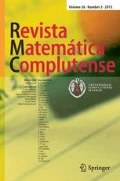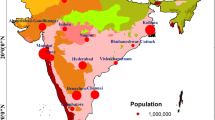Abstract
The space-time cube is not a cube of course, but the idea of one is useful. Its base is a spatial domain, \(D_t\), and the “cube” is traced out by a process of spatial domains, \(\{D_t:t\ge 0\}\). Now fill the cube with a spatio-temporal stochastic process \(\{Y_t(\mathbf{s} ):\mathbf{s} \in D_t,t\ge 0\}\). Assume that \(\{D_t\}\) is fixed and known (but clearly it too could be stochastic). Slicing the cube laterally for a fixed \(t_0\) generates a spatial stochastic process \(\{Y_{t_0}(\mathbf{s} ):\mathbf{s} \in D_{t_0}\}\). Slicing the cube longitudinally for a fixed \(\mathbf{s} _0\) generates a temporal process \(\{Y_t(\mathbf{s} _0):t\ge 0\}\) that, after dicing, yields a time series, \(\{Y_0(\mathbf{s} _0),Y_1(\mathbf{s} _0),\ldots \}\). These are the main highways that traverse the cube but other, less-traveled paths, can be taken. In this paper, we discuss spatio-temporal data and processes whose domain is the space-time cube, and we incorporate them into hierarchical statistical models for spatio-temporal data.




Similar content being viewed by others
References
Bartlett, M.S.: The approximate recovery of information from replicated field experiments with large blocks. J. Agric. Sci. 28, 418–427 (1938)
Bergmann, P.G.: Introduction to the Theory of Relativity. Dover, New York (1976)
Berliner, L.M.: Hierarchical Bayesian time-series models. Maximum Entropy and Bayesian Methods, pp. 15–22. Kluwer Academic Publishers, Dordrecht (1996)
Besag, J.E.: Spatial interaction and the statistical analysis of lattice systems. J. R. Stat. Soc. Ser. B 36, 192–225 (1974)
Brownie, C., Gumpertz, M.L.: Validity of spatial analyses for large field trials. J. Agric. Biol. Environ. Stat. 2, 1–23 (1997)
Burrough, P., McDonnell, R.A.: Principles of Geographical Information Systems, 2nd edn. Oxford University Press, Oxford (1998)
Carlin, B.P., Louis, T.A.: Bayes and Empirical Bayes Methods for Data Analysis. Chapman and Hall/CRC, Boca Raton (2000)
Cressie, N.: Change of support and the modifiable areal unit problem. Geogr. Syst. 3, 159–180 (1996)
Cressie, N.: Mission CO\(_2\)ntrol: A statistical scientist’s role in remote sensing of atmospheric carbon dioxide. J. Am. Stat. Assoc. 113, 152–181 (2018). (with discussion)
Cressie, N., Wikle, C.K.: Statistics for Spatio-Temporal Data. Wiley, Hoboken (2011)
Donahue, J., Hendricks, A.L., Guadarrama, S., Rohrbach, M., Venugopalan, S., Saenko, K., Darrell, T.: Long-term recurrent convolutional networks for visual recognition and description. In: Proceedings of the IEEE Conference on Computer Vision and Pattern Recognition, pp. 2625–2634 (2015)
Fairfield Smith, H.: An empirical law describing heterogeneity in the yields of agricultural crops. J. Agric. Sci. 28, 1–23 (1938)
Federer, W.T., Newton, E.A., Altman, N.S.: Combining standard block analyses with spatial analyses under a random effects model. Modelling Longitudinal and Spatially Correlated Data, pp. 373–386. Springer, New York (1997)
Fisher, R.A.: The Design of Experiments. Oliver and Boyd, Edinburgh (1935)
Ghysels, E.: Macroeconomics and the reality of mixed frequency data. J. Econom. 193, 294–314 (2016)
Goodfellow, I., Bengio, Y., Courville, A.: Deep Learning. MIT Press, Cambridge (2016)
Grondona, M.O., Cressie, N.: Using spatial considerations in the analysis of experiments. Technometrics 33, 381–392 (1991)
Grondona, M.O., Cressie, N.: Efficiency of block designs under stationary second-order autoregressive errors. Sankhyā A 55, 267–284 (1993)
Heine, M.: Models for two-dimensional stationary stochastic processes. Biometrika 42, 170–178 (1955)
Legendre, P., Dale, M.R.T., Fortin, M.-J., Casgrain, P., Gurevitch, J.: Effects of spatial structures on the results of field experiments. Ecology 85, 3202–3214 (2004)
McCullagh, P., Clifford, D.: Evidence for conformal invariance of crop yields. Proc. R. Soc. Ser. A 462, 2119–2143 (2006)
McDermott, P.L., Wikle, C.K.: An ensemble quadratic echo state network for non-linear spatio-temporal forecasting. Stat 6, 315–330 (2017)
McDermott, P.L., Wikle, C.K.: Deep echo state networks with uncertainty quantification for spatio-temporal forecasting. Environmetrics 30, e2553 (2019)
Micheas, A.: Theory and Modeling of Stochastic Objects: Point Processes and Random Sets. Chapman & Hall/CRC Press, Boca Raton (2020). (forthcoming)
Papadakis, J.: Méthode statistique pour des expériences sur champ. Bulletin Scientifique, No. 23, pp. 13–29, Institut d’Amélioration des Plantes à Salonique, Greece (1937)
Robinson, W.S.: Ecological correlation and the behavior of individuals. Am. Sociol. Rev. 15, 351–357 (1950)
Samek, W., Montavon, G., Vedaldi, A., Hansen, L.K., Müller, K.-R.: Explainable AI: Interpreting. Explaining and Visualizing Deep Learning. Springer, Heidelberg (2019)
Simpson, E.H.: The interpretation of interaction in contingency tables. J. R. Stat. Soc. Ser. B 13, 238–241 (1951)
Sparks, J.: The Works of Benjamin Franklin, vol. 10. Hilliard, Gray & Company, Boston, MA (1840)
Takens, F.: Detecting strange attractors in turbulence. Dynamical Systems and Turbulence, Warwick 1980, pp. 366–381. Springer, Berlin, DE (1981)
Tobler, W.R.: A computer movie simulating urban growth in the Detroit region. Econ. Geogr. 46, 234–240 (1970)
Whittle, P.: On stationary processes in the plane. Biometrika 41, 434–449 (1954)
Whittle, P.: Systems in Stochastic Equilibrium. Wiley, Chichester (1986)
Wikle, C.K.: Comparison of deep neural networks and deep hierarchical models for spatio-temporal data. J. Agric. Biol. Environ. Stat. 24, 175–203 (2019)
Wikle, C.K., Berliner, L.M., Cressie, N.: Hierarchical Bayesian space–time models. Environ. Ecol. Stat. 5, 117–154 (1998)
Wikle, C.K., Zammit-Mangion, A., Cressie, N.: Spatio-Temporal Statistics with R. Chapman & Hall/CRC Press, Boca Raton, FL (2019)
Zammit-Mangion, A., Ng, T.L. J., Vu, Q., Filippone, M.: Deep compositional spatial models. (2019) arXiv Preprint (arXiv:1906.02840)
Zammit-Mangion, A., Wikle, C. K.: Deep integro-difference equation models for spatio-temporal forecasting. Spat. Stat. (2020). https://doi.org/10.1016/j.spasta.2020.100408
Acknowledgements
Material from Chapters 1, 2, and 6 of [10] is used with permission from the publisher: Copyright ©(2011) by John Wiley and Sons, Inc. All rights reserved. Cressie’s research was supported by ARC Discovery Project DP190100180. Wikle’s research was supported by NSF grants SES-1853096 and DMS-1811745.
Author information
Authors and Affiliations
Corresponding author
Additional information
Publisher's Note
Springer Nature remains neutral with regard to jurisdictional claims in published maps and institutional affiliations.
Rights and permissions
About this article
Cite this article
Cressie, N., Wikle, C.K. Measuring, mapping, and uncertainty quantification in the space-time cube. Rev Mat Complut 33, 643–660 (2020). https://doi.org/10.1007/s13163-020-00359-7
Received:
Accepted:
Published:
Issue Date:
DOI: https://doi.org/10.1007/s13163-020-00359-7
Keywords
- Change-of-support
- Uncertainty quantification
- Space-time interaction
- Hierarchical statistical model
- Deep neural models
- Stochastic PDE




